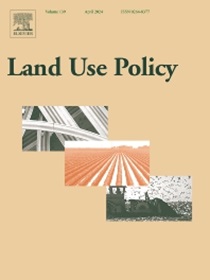沙洲植树造林的潜在环境影响:印度阿萨姆邦雅鲁藏布江沙洲生态系统恢复行动的启示
IF 6
1区 社会学
Q1 ENVIRONMENTAL STUDIES
引用次数: 0
摘要
在河流沙洲植树造林是恢复生态系统的绝佳机会,具有提高碳储量的巨大潜力。在荒岛上植树造林是一项具有挑战性的任务;然而,Padmashree Jadav Payeng 凭借一己之力将印度东北部阿萨姆邦的雅鲁藏布江沙洲变成了森林景观。这种鼓舞人心的举措需要更多的关注,需要进行科学评估,以量化生态系统价值和通过此类活动可丰富的服务。本研究利用遥感数据,即 Landsat4-5TM 和 Sentinel 2 A 数据,提供了 1990 年至 2021 年研究区域土地利用土地覆被时空变化的详细信息。该研究旨在对沙洲发生的生物物理变化进行科学系统的评估,了解植树造林的现状,并评估选定沙洲目前的地上生物量(AGB)、地下生物量(BGB)和碳储量水平。利用合成孔径雷达反向散射与实地 AGB 之间的线性回归模型,得出了 AGB、BGB 和碳储量的空间分布。结果表明,从 1990 年到 2021 年,森林覆盖率增加了 31.92%,沙洲面积减少了 26.87%。空间推导的 AGB 为每公顷 9 至 1295.89 兆克,BGB 为每公顷 2.35 至 290.50 兆克,碳储量为每公顷 6.18 至 763.34 兆克。宗教榕的生物量较高,从每公顷 564.7 兆克到 994.7 兆克不等,碳储量较高,从每公顷 8 兆克到 557.30 兆克不等,这归功于其较大的胸径(DBH)。此外,还对所研究的森林进行了植物社会学评估,结果显示其树种总丰富度为 79。该森林的树木总密度为每公顷 395 株。不同的生物多样性指数提供了对物种组成的全面了解;结果显示,香农多样性指数为 2.81,辛普森指数为 0.08,梅尼尼克丰富度指数为 2.7,马加勒夫丰富度指数为 5.26。文章详细介绍了森林覆盖率的变化以及 AGB、BGB 和碳储量的现状,为生态系统的恢复提供了基于证据的说明。一个人的倡议创造了森林景观和大量野生动物的栖息地,有助于提高碳储量和生态系统的健康水平。关于当前碳市场的争论,研究建议有必要将碳信用额工具化,用于此类恢复活动,以鼓励增加碳储量。研究还得出结论,应深入研究此类植树造林活动的长期有效性,以及从减缓气候变化和可持续森林发展的角度扩大这些生态系统恢复举措的潜力。本文章由计算机程序翻译,如有差异,请以英文原文为准。
Potential environmental implications of sandbar afforestation: Insights from ecosystem restoration initiatives in a sandbar of Brahmaputra River Assam, India
Plantation in riverine sandbars offers an excellent opportunity for restoration of ecosystem with a vast potential for enhancing carbon stock. Afforestation on barren islands is challenging task; however, Padmashree Jadav Payeng has single-handedly transformed a sandbar of the river Brahmaputra into a forested landscape in India’s northeastern state of Assam. Such inspiring initiative needs more attention in terms of scientific assessment to quantify ecosystem value and services that can be enriched through such activities. This study uses remote sensing data viz., Landsat4–5TM and Sentinel 2 A data to provide a detailed information on spatio-temporal variability of land use land cover of study region from 1990 to 2021. It aims to conduct a scientific and systematic assessment of biophysical changes that have occurred in the sandbars, understand the status of afforestation, and evaluate the current levels of aboveground biomass (AGB), belowground biomass (BGB), and carbon stock in the selected sandbars. The spatial distribution of AGB, BGB and carbon stock is derived using linear regression model between SAR backscatter and field-based AGB. The results demonstrate that forest cover increased by 31.92 % and sandbar area is reduced by 26.87 % from 1990 to 2021. Spatially derived AGB ranges from 9 to 1295.89 Mg per ha, BGB from 2.35 to 290.50 Mg per ha and carbon stock from 6.18 to 763.34 Mg per ha. Ficus religiosa exhibits a high biomass, ranging from 564.7 Mg per ha to 994.7 Mg per ha, and a high carbon stock, ranging from 8 to 557.30 Mg per ha, attributed to its larger diameter at breast height (DBH). Moreover, phytosociological assessment was conducted for the studied forest, which reveal a total tree species richness of 79. The forest exhibits a total tree density of 395 individuals per hectare. Different biodiversity indices provide a comprehensive understanding of species composition; where results show a Shannon diversity index of 2.81, a Simpson's index of 0.08, a Menhinick's richness index of 2.7, and a Margalef's richness index of 5.26. The article provides detailed information on change in forest cover and present status of AGB, BGB and Carbon stock, providing evidence-based narratives on ecosystem restoration. The initiative by a single person has created a forested landscape and habitat for a large number of wild animals, contributing to better carbon stock and a healthier ecosystem. With regard to the current debate of carbon market, the study suggests the need of instrumentalization of carbon credits for such restoration activities to encourage increase in carbon stock. It also concludes that in-depth research should be taken up on long-term effectiveness of such plantation activities and the potential for scaling up these initiatives for ecosystem restoration in view of climate change mitigation and sustainable forest development.
求助全文
通过发布文献求助,成功后即可免费获取论文全文。
去求助
来源期刊

Land Use Policy
ENVIRONMENTAL STUDIES-
CiteScore
13.70
自引率
8.50%
发文量
553
期刊介绍:
Land Use Policy is an international and interdisciplinary journal concerned with the social, economic, political, legal, physical and planning aspects of urban and rural land use.
Land Use Policy examines issues in geography, agriculture, forestry, irrigation, environmental conservation, housing, urban development and transport in both developed and developing countries through major refereed articles and shorter viewpoint pieces.
 求助内容:
求助内容: 应助结果提醒方式:
应助结果提醒方式:


